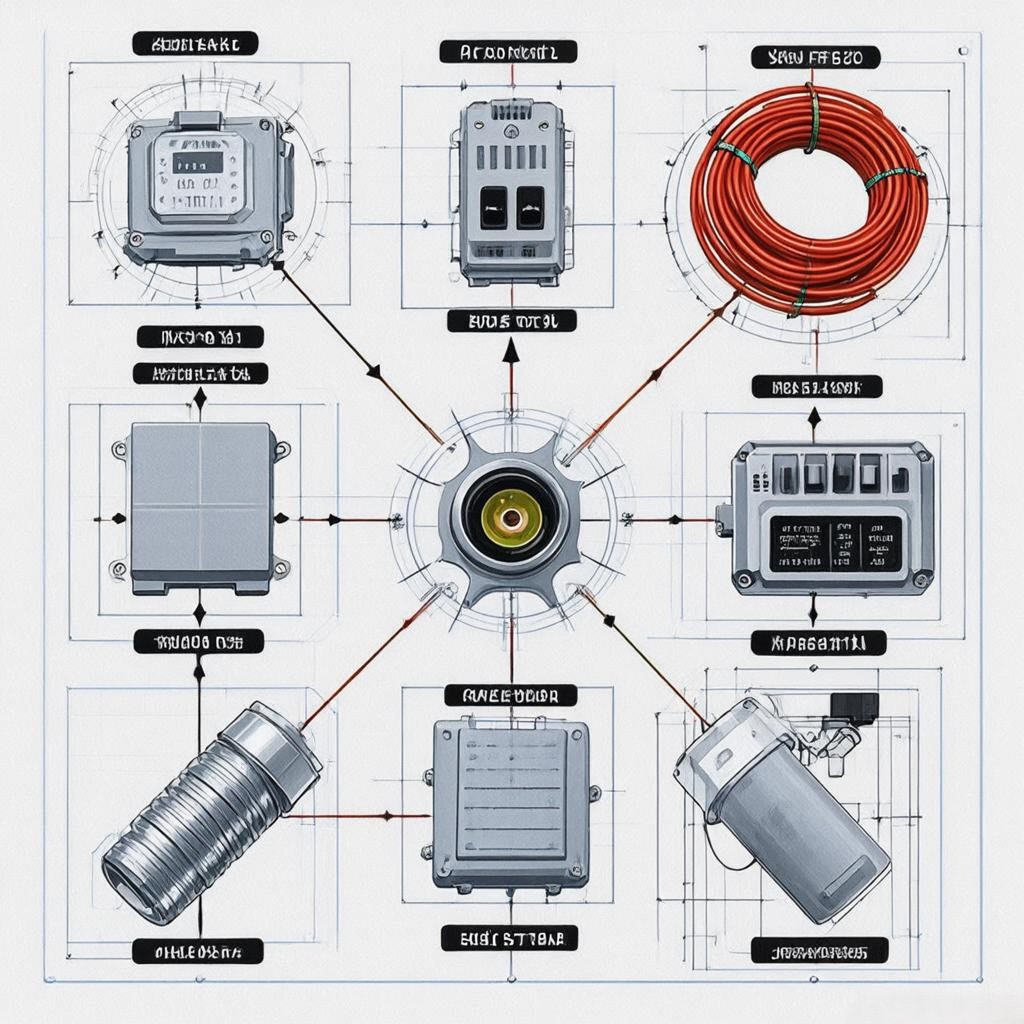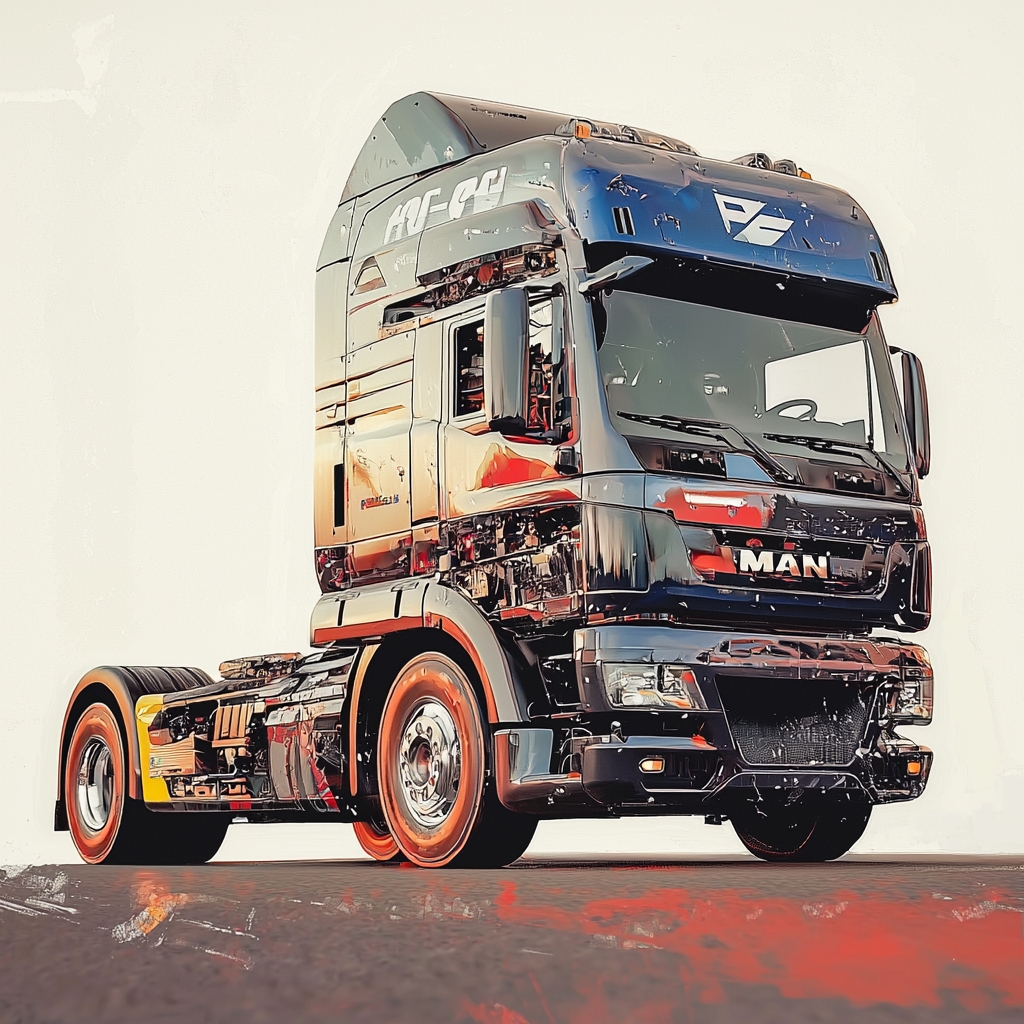The engine and drivetrain represent the beating heart and vascular system of any vehicle, working in perfect harmony to convert fuel into motion. This comprehensive technical exploration delves into the intricate components that constitute modern powertrains, examining their functional relationships, advanced technologies, and the ongoing innovations that are reshaping automotive engineering. From combustion chambers to wheel hubs, we’ll analyze how these systems deliver power with precision, efficiency, and reliability.



1. The Power Generation System: Internal Combustion Engines
1.1 Core Engine Components
The modern internal combustion engine (ICE) remains a marvel of mechanical engineering, combining precision components to convert chemical energy into mechanical work:
- Pistons & Connecting Rods: Aluminum alloy pistons (2.5-3.0 kg) with forged steel connecting rods withstand 15-20 MPa combustion pressures.
- Crankshaft: Forged steel crankshafts (50-100 kg) with counterweights balance reciprocating forces while maintaining 0.01mm dimensional tolerances.
- Cylinder Head: Aluminum alloy heads (3-5 kg) feature multi-valve configurations (4-5 valves/cylinder) and direct injection ports with 0.2mm diameter nozzles.
Performance metrics:
- Thermal efficiency: 25-40% (with advanced turbocharging reaching 45%)
- Maximum combustion pressure: 18-22 MPa in performance engines
- RPM range: 6,000-15,000 RPM for sports engines
1.2 Fuel Delivery & Air Management
Modern engines employ sophisticated systems to optimize air-fuel mixture:
- Direct Injection Systems: 2,000-3,000 bar fuel pressure with piezo-electric injectors (5-7 holes, 0.12mm diameter)
- Variable Valve Timing (VVT): Hydraulic or electric actuators adjusting camshaft phasing ±50°
- Turbochargers: Twin-scroll turbines with variable geometry vanes (VGT) achieving 2.5-3.5 bar boost pressure
Emission control:
- Gasoline Particulate Filters (GPF): 99% particulate matter capture efficiency
- Selective Catalytic Reduction (SCR): AdBlue injection for NOx reduction (conversion rate >90%)
2. The Drivetrain System: Power Transmission Components
2.1 Transmission Systems
The transmission bridges the engine and driveline, offering various configurations:
- Manual Transmissions (MT):
- 5-6 speed gearboxes with synchromesh mechanisms
- Clutch discs (220-280mm) with organic/ceramic friction materials
- Shift forks (aluminum alloy) with hydraulic actuation
- Automatic Transmissions (AT):
- 8-10 speed planetary gearsets with torque converters (stall torque ratio 1.8-2.5)
- Hydraulic control systems with 8-12 solenoid valves
- Electronic control units (ECUs) processing 1,000+ signals/second
- Dual-Clutch Transmissions (DCT):
- Wet-clutch systems with oil cooling (flow rate 10-15 L/min)
- Gear pre-selection mechanisms reducing shift times to <0.2 seconds
- Mechatronic control units integrating hydraulic and electronic actuation
Efficiency metrics:
- Manual: 95-98% gear engagement efficiency
- Automatic: 85-92% efficiency (improving with 8+ speeds)
- DCT: 91-96% efficiency with rapid shift characteristics
2.2 Driveline Components
The driveline transmits power from transmission to wheels:
- Drive Shafts:
- Steel tubes (70-100mm diameter) with universal joints (operating angle 45°)
- Constant Velocity (CV) joints for front-wheel drive (operating angle 50°)
- Two-piece designs with center support bearings for longer shafts
- Differentials:
- Open differentials with 40-50% torque bias ratio
- Limited-slip differentials (LSD) using clutch packs or viscous coupling
- Electronic LSD systems with torque vectoring capabilities
- Axles:
- Half-shafts (30-50mm diameter) with constant velocity joints
- Live axles for heavy-duty applications (load capacity 5,000-10,000 kg)
Material innovations: Forged alloy steel (1045/4140) with surface hardening (carburizing or nitriding)
3. Advanced Powertrain Technologies
3.1 Hybrid Powertrains
Combining ICE with electric motors for improved efficiency:
- Mild Hybrids (48V):
- Belt-integrated starter generators (BISG) producing 10-20 kW
- Lithium-ion batteries (0.5-1.0 kWh) enabling coasting and mild boost
- Regenerative braking recovering 10-15% of kinetic energy
- Full Hybrids (HEV):
- Parallel or series-parallel architectures
- Electric motors (50-100 kW) with nickel-metal hydride or lithium-ion batteries (1.0-2.5 kWh)
- Power-split devices using planetary gearsets (Toyota Hybrid System)
- Plug-in Hybrids (PHEV):
- Larger battery packs (8-16 kWh) enabling 50-100 km electric range
- Dual charging systems (AC 3.7kW/DC 50kW)
- Range-extender configurations with small displacement engines
3.2 Electric Powertrains
Completely eliminating mechanical complexity:
- Electric Motors:
- Permanent Magnet Synchronous Motors (PMSM) with 95-97% efficiency
- Induction motors for high-power applications (Tesla Model S: 300 kW)
- Axial flux motors offering higher power density (up to 10 kW/kg)
- Power Electronics:
- Inverters converting DC to 3-phase AC (switching frequency 5-20 kHz)
- Silicon Carbide (SiC) MOSFETs reducing losses by 50% vs. IGBTs
- Battery Management Systems (BMS) with 128-cell monitoring resolution
- Battery Systems:
- Lithium-ion chemistries (NMC, LFP, solid-state prototypes)
- 400-800V architectures for reduced current and higher efficiency
- Thermal management with liquid cooling (ΔT <5°C across pack)
4. System Integration & Performance Optimization
4.1 Powertrain Control Systems
Modern vehicles use sophisticated ECUs to manage power delivery:
- Engine Control Unit (ECU):
- 32-bit microcontrollers running at 200MHz+
- 200+ sensor inputs (knock sensors, O2 sensors, MAP sensors)
- Closed-loop control with <10ms response time
- Transmission Control Unit (TCU):
- Gear shift maps with 100+ parameters
- Torque converter lockup strategies
- Adaptive learning algorithms for driver behavior
- Hybrid Control Unit (HCU):
- Energy management algorithms optimizing battery usage
- Regenerative braking coordination
- Power split control in series/parallel hybrids
Integration challenges:
- CAN FD communication (5Mbps bandwidth)
- Functional safety (ISO 26262 ASIL C/D requirements)
- Over-the-air (OTA) software updates
4.2 Thermal Management Systems
Efficient cooling is critical for performance and longevity:
- Engine Cooling:
- Water pumps (10-20L/min flow rate)
- Thermostatic valves controlling coolant flow
- Electric cooling fans (500-2,000W power)
- Transmission Cooling:
- Oil-to-air or oil-to-water heat exchangers
- Filtered oil coolers (10-20μm filtration)
- Temperature sensors (±2°C accuracy)
- Battery Cooling:
- Liquid cooling plates with 0.2mm channels
- Refrigerant-based systems for fast charging
- Thermal insulation (λ <0.04 W/mK)
5. Future Trends & Innovations
5.1 Electrification & Alternative Fuels
- Fuel Cell Vehicles (FCEV):
- Proton Exchange Membrane (PEM) fuel cells (50-100 kW)
- Hydrogen storage at 700 bar (5-10 kg capacity)
- Overall efficiency: 40-60%
- Synthetic Fuels:
- E-fuels produced from renewable energy
- Compatibility with existing ICE infrastructure
- Potential for carbon-neutral transportation
- Solid-State Batteries:
- Energy density: 400-500 Wh/kg (vs. 250-300 Wh/kg for Li-ion)
- Faster charging (10-15 minutes to 80%)
- Improved safety with solid electrolytes
5.2 Lightweighting & Materials
- Carbon Fiber Reinforced Polymers (CFRP):
- Drivetrain components 40-60% lighter than steel
- Specific stiffness: 200 GPa/(g/cm³)
- Manufacturing challenges: Cost and repairability
- Additive Manufacturing:
- 3D-printed metal components with optimized topology
- Complex cooling channel designs
- Reduced material waste (up to 90% less vs. traditional machining)
- Smart Materials:
- Shape-memory alloys for adaptive components
- Piezoelectric materials for energy harvesting
- Self-healing polymers for extended component life
5.3 Autonomous Vehicle Requirements
- Redundant Powertrains:
- Dual-motor configurations for fault tolerance
- Fail-operational electronic control systems
- Multiple sensor fusion for propulsion control
- Predictive Maintenance:
- Vibration monitoring with embedded sensors
- Oil condition analysis (particle counting, viscosity)
- AI-based failure prediction algorithms
- Energy Efficiency:
- Regenerative braking optimization
- Predictive cruise control adjusting power delivery
- Eco-driving algorithms minimizing energy consumption
Conclusion: The Evolution of Powertrain Technology
The engine and drivetrain continue to evolve at an unprecedented pace, driven by demands for greater efficiency, reduced emissions, and enhanced performance. From the precision engineering of combustion engines to the sophisticated electronics of electric powertrains, modern vehicles represent the pinnacle of mechanical and electrical integration.
Key takeaways:
- ICEs remain highly refined with advanced emission control and efficiency technologies
- Hybrid and electric powertrains are rapidly gaining market share
- Lightweight materials and additive manufacturing are transforming component design
- Software and electronics are becoming as important as hardware in powertrain development
Final thought: As we stand at the crossroads of internal combustion and electrification, the future of mobility will be shaped by innovations that balance performance, efficiency, and sustainability. The next generation of powertrains will not only move us from point A to B but will do so with unprecedented levels of intelligence, efficiency, and environmental responsibility.
Call to Action
🔧 Exploring powertrain solutions for your application?
⚙️ Contact our engineering team for customized drivetrain designs
📊 Request technical specifications on the latest hybrid/electric powertrain components
#EngineTechnology, #DrivetrainSystems, #HybridVehicles, #ElectricPowertrains, #AutomotiveEngineering, #PowertrainInnovation, #SustainableMobility, #FutureOfTransportation, #VehicleDynamics, #AdvancedMaterials



